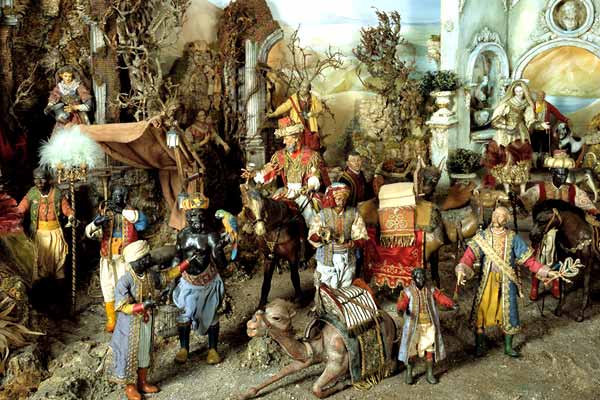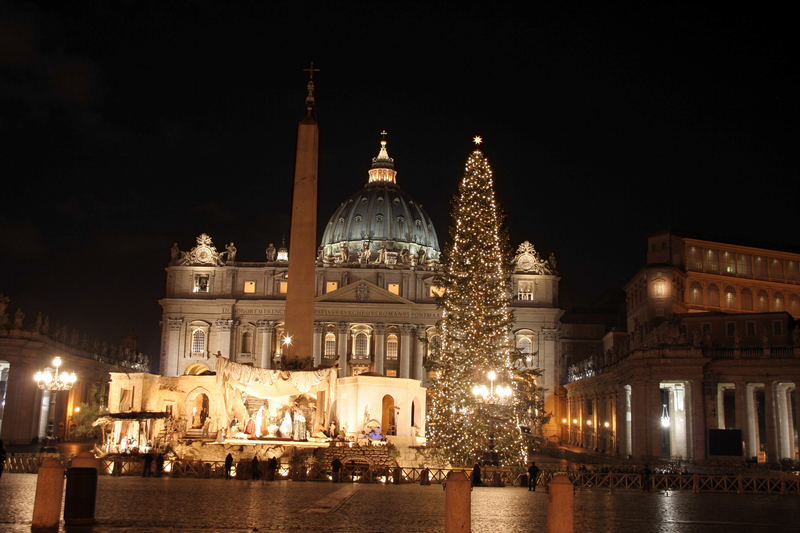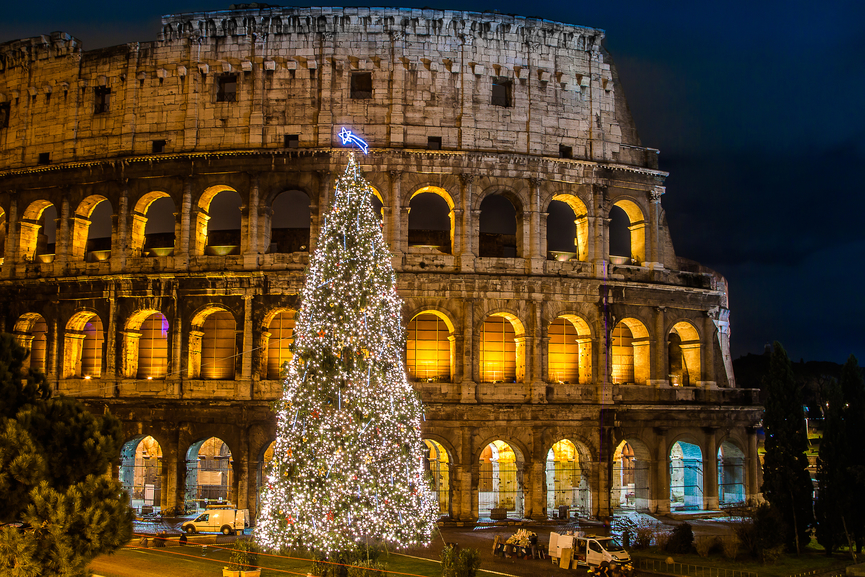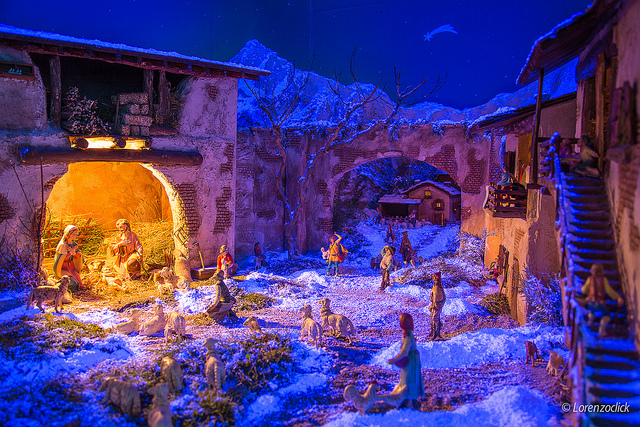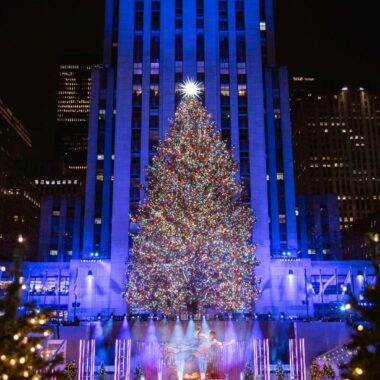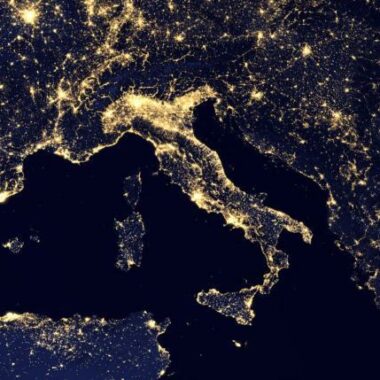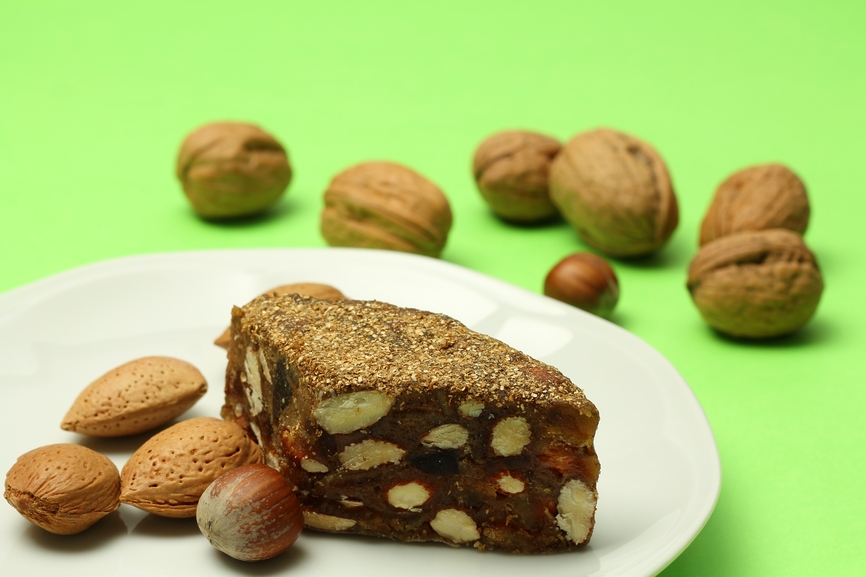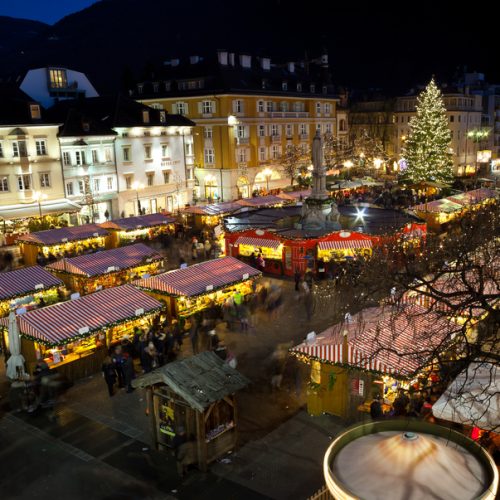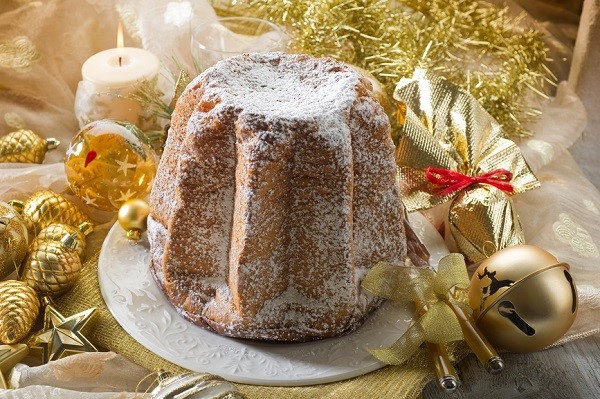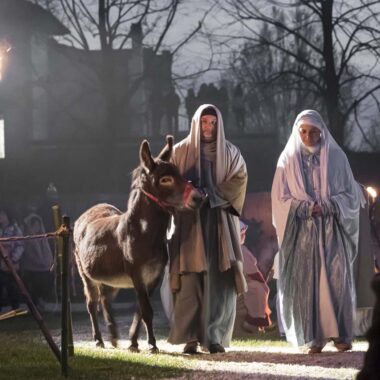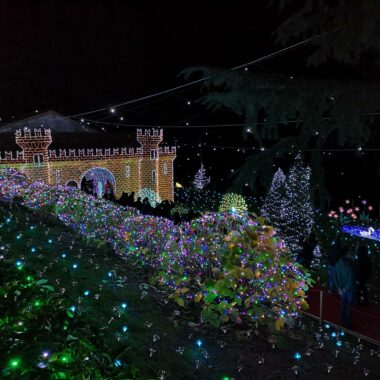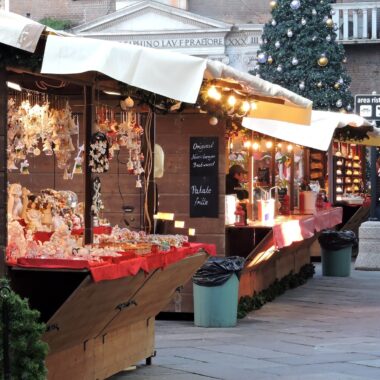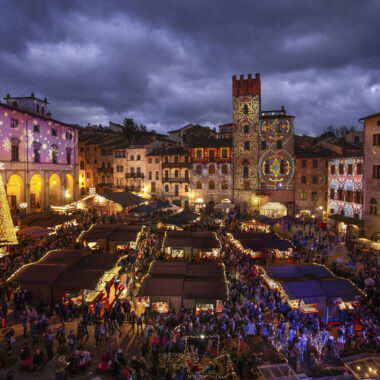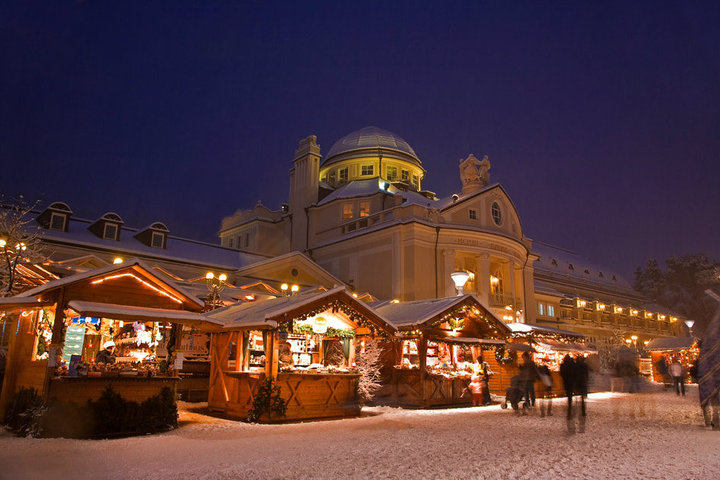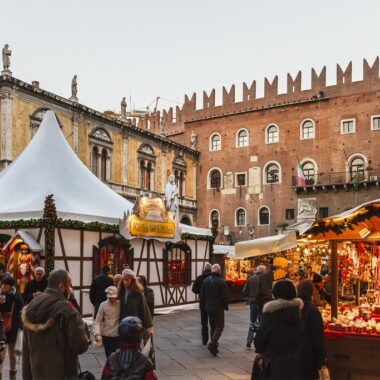My Christmas is going to be very special. I just moved into a new apartment, in an old building that sits just beside one of the town churches. On the stairs that lead to my place, there is a little, wooden door you wouldn’t even notice unless you knew it’s there, as it has been painted the same color as the walls.
Well, if you open that little door, you’ll find a flower-shaped window that overlooks the basilica: it’s amazingly beautiful and it gives me an enormous sense of peace, this being able to look into the eye of art, beauty and spirituality in such a private manner. It is a moment of touching intimacy and, in many a way, of awe.
There is more to it: sounds fly, light and ethereal, through my little flower-shaped window with astonishing clarity, so, every time there is a sung mass (everyday, in this parish) and the choir rehearses (twice or thrice a week), I open my door and enjoy a magnificent concert. Even the basilica’s many bells play a Christmas musical motif at least two times during the day.
First row tickets, backstage passes.
As Christmas approaches of course, rehearsal sessions increase, and live music comes to my ears even more often than usual. Christmas songs are performed continuously and I find myself singing along more often than not: what an amazing way to enjoy Christmas and its spirit! Nothing is better than music and the scent of orange peels burning on the stovetop to remind you Christmas is on its way.
Italy, of course, enjoys plenty of seasonal songs well known around the world: we adore the Rat Pack, and plenty of pieces once specifically associated to Catholic tradition, such as Adeste Fideles or Silent Night (German in origin and translated in Italian as Astro del Ciel, Star of the Sky) have become household favorites, even if you don’t go to church. But did you know that the very first Christmas chants were actually born in Italy? Well, ok… the country had it easy for that, as Rome became the cradle of Christianity soon after the death of Christ, yet, not many are aware of the role of Italy in the development of Christmas music, and it may be that many of you are not familiar with our favorite tunes.
As a little Christmas present from we at lifeinitaly to you all, here is a shiny brand new piece on the musical heritage of Christmas in Italy. If you are planning to enjoy some Italian traditional cheer during the holidays, then play these in the background and imagine you, too, have your own little, flower-shaped window that opens onto an Italian 18th century basilica by the sea, and enjoy the magic.
Buon Natale a tutti voi!
Italian Christmas music: some historical background
Christmas music has ancient roots in Christian liturgy: before the songs we all know and love, Christmas chants were Latin hymns replete with theological meaning. These were already part of Christmas celebrations at the time of their first known attestation, in the 4th century AD: it was a century of great saints and Fathers of the Church and it was, indeed, one of them, Saint Ambrose of Milan, bishop and theologian, to compose one of the first known liturgical hymns celebrating the Nativity, the Veni, Redemptor Gentium (it translates as “Come, Redeemer of the people”), a theological rendition of the meaning of Christmas.
And in truth, for the first centuries of its celebration, Christmas music was mostly like that: heavy, solemn and conceptually dense pieces, that little had to do with those sceneries, so familiar to us, filled with shepherds, angels and shaped in their sonority and meaning by a fulfilling sense of maternal love and godly awe. These were pieces centred on the ideas of the Word’s Incarnation, Jesus, and human Redemption through His sacrifice.
It is thanks to an immensely loved spiritual figure of Italy that, in the 13th century, Christmas music turns, from exposition and explanation of Christian theological ideas, to representation of love and devotion to the Son of God. Saint Francis of Assisi brought Jesus’ humble humanity, and the tender love of His Mother to center stage, leaving theology and its interpretation to the scriptoria of monasteries.
At Christmas time, people were given chants celebrating love: that of Jesus for Mankind, that of Mary for Her Son and that of Mankind for both. In spite of having marked such a huge shift in content and message, Francis did not leave us any composition, even though his importance in relation to Christmas is well marked by fact he created the first presepe. It is also for this reason Saint Francis is often remembered with tenderness around this time of the year.
Shortly after Francis’ death, Franciscan monks began composing the first “modern” Christmas odes: their work embraced and described that sense of love, peace and warmth we associate to Christmas today. The main difference between these compositions and the theological hymns of previous centuries was, beside of course the very register and content of them, the fact they were composed in vulgar Italian and not in Latin. For those of you not familiar with the terminology, “vulgar” does not refer to something coarse, but to the language that evolved from Latin throughout the centuries and that, by then, was spoken by a large majority of people. In these chants, newborn Jesus is often described with profound human love: dolce nostro fratellino (our sweetest little brother), bambolino (little doll), Jesulino (little Jesus), these are only some of the expressions used to described the child Jesus of Christmas by Franciscans in those late centuries of the Middle Ages, and early decades of the Renaissance.
The 17th century, when our most beautiful Christmas song was born
If the change of direction in content happened during and soon after the life of Saint Francis of Assisi (13thcentury), it is the 17th that gave to we Italians our best loved Christmas song, the wonderful, touching Tu Scendi dalle Stelle (From Starry Skies thou comest). Composed by the founder of the Congregation of the Most Holy Redeemer, Alfonso Maria de Liguori, bishop first, Father of the Church and saint after, this is very likely our favorite Christmas carol. It is traditionally played at the end of midnight mass in St Peter’s every Christmas Eve, and it is the first Christmas song we learn to sing as children. Its lyrics symbolize to perfection that ideal of love for newborn Jesus that Saint Francis had proposed, and its melody is beautiful and poignant. Tu Scendi dalle Stelle is traditionally played by zampogne, an Italian variety of bagpipes and is hands-down, a quintessential Italian christmas song.
It has been translated in many a language, including English, where its title has been rendered as “From Starry Skies Thou Comes,” “From Starry Skies Descending,” “You Came a Star from Heaven,” “You Come Down from the Stars” but, although popular, it has nowhere in the world the same popularity it has in Italy.
To many, Liguori’s lyrics reflect perfectly the very image of the Nativity Saint Francis wanted to communicate to Christian more than 700 years ago, an image made of love and a profound sense of awe for what that newly born child was to do for Humankind.
Tu Scendi dalle Stelle, performed by the polyphonic choir of Castellamare di Stabia
The 18th Century and Adeste Fideles
Technically, Adeste Fideles may not have been composed in Italy; in truth, there is very little knowledge of where exactly the hymn hails from and we do not even have the name of its author, but only of its copist, Sir John Francis Wade: he transcribed its melody and 4 of its 7 stanzas. It was performed, or so it is attested, for the first time in northern France, more precisely at Douai, in the mid 17th century, when the town was an important Catholic center, as well as a safe haven for persecuted Catholics from the British Islands. The missing three stanzas, namely the second, the third and the forth were composed around 1794 by Étienne-Jean-François Borderies. One more stanza was added by an anonymous author later.
Adeste Fideles performed in St Peter’s Basilica in 2012
Adeste Fideles is, then, an international Christmas song, really, and its ties to Italy could come mostly by the fact its original lyrics are in Latin. It is one of those songs we love to listen to around Christmas time, as it is a magnificent mix of popular devotion and Catholic tradition: the first attested by that sense of profound faithful love to Christ expressed by its lyircs, the latter embodied by the rich resonance of the Latin language.
The 19th Century and Stille Nacht
In 1816, Father Joseph Mohr composed Stille Nacht! Heilige Nacht!, “Silent Night” for the Anglophones, and “Astro del Ciel” for we Italians. It was performed for the first time on Christmas Eve 1818, its music created by Franz Gruber. Originally conceived as a lullaby inviting children to rest within “the peace of Heaven,” this hymn conquered with its simplicity almost every corner of the known world: just think that it has been translated in more than 140 different languages. In Italy, Astro del Ciel is regularly performed as a carol, but also in church. Its English version, Silent Night, is also known and performed relatively often. Paradoxically, the original German is not very popular, in spite of being the earliest rendition of the song. This, of course, is not true for Trentino Alto-Adige where, I am sure, Stille Nacht is performed as often as Astro del Ciel. Whichever language, this is certainly one of the best known traditional Christmas songs, in Italy, just as everywhere else in the world, full of charm, beauty and somehow reminding me always of the sweet and spicy scent of gingerbread cookies!
Astro del Ciel performed by Laura Pausini
The 20th century and White Christmas
Who does not know White Christmas? Just as everywhere else in the world, this is one of Italy’s best liked carols, although it is usually performed in translation, with the title of Bianco Natale. The song was composed in 1940 by famous US musician Irving Berlin, who allegedly was taken by a creative afflatus late at night, and did not jot down the melody until the morning after, when he boasted to his secretary he had just come out with the most legendary of tunes. It may have seemed boisterous at that time. It turns out Berlin was pretty much right about it.
Without a doubt, however, the most famous and best loved rendition of White Christmas is that by Bing Crosby, who recorded it in 1942. Even in Italy, the song is greatly associated to the US crooner, in spite of having been performed by many artists.
A different version of Bianco Natale with Irene Grandi
Jingle Bells and all the others
If Tu Scendi dalle Stelle, Astro del Ciel, Adeste Fideles and Bianco Natale are very likely the most performed among all Christmas songs, Italy knows and loves pretty much all the music you listen to in the US and other parts of the World, too. All those Christmas tunes pop singers churn out every year just on time to sell some more on iTunes for the holidays? Check. Their reinterpretation of classical hymns, ready packed and as tacky as hell (Beyoncé’s R&B version of White Christmas? Twisted Sisters’ heavy metal version of Adeste Fideles? No thanks), check. Some of these, though, became new classics in their own right, like Last Christmas by the Wham or Happy Xmas (war is over), by John Lennon, and are very much part of Christmas tradition now: the horizon of Italian Christmas music has widened and went beyond those traditional tunes that were around when I was a child. Often though, these songs are not really about Christmas at all: what about East 17’s Stay Another Day, or Mariah Carey’s All I want for Christmas is you? They have very little to do with Christmas as a festivity, yet they are pumped on all radios starting from late November and pretty much everyone can sing along.
As you can see, when it comes to Christmas, our musical traditions do not differ much from yours, or from those of the majority of those celebrating Christmas in the world. This is, in a way, a result of the very essence of Christmas, which is a foremost Christian festivity and, well… there are plenty of Christians in the world! There is more to it, though, I think. I, personally, do celebrate Christmas as a religious day, because I am a practicing Catholic, but I have so many friends, agnostics or even atheists, who do love this time of the year and enjoy celebrating as much as I do: it is the sudden closeness to one’s family, even when distances separates people for the rest of the year, it is the idea of spending time together and, I believe, it is the fact that, in these days of holidays, we all tend to remember with much more clarity our childhood, the time when Christmas is at its most beautiful, because seen and enjoyed as a moment of sheer happiness and owe.
This is why we all enjoy the same songs and the same music, this is why there is so much in common in the way we celebrate Christmas all over the world.




